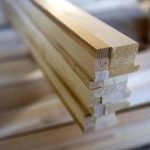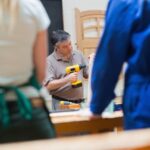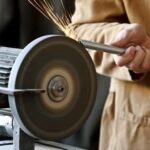Are N95 masks good for woodworking? When it comes to respiratory protection in woodworking, the choice of mask is crucial. Woodworking activities can generate a significant amount of wood dust and other particles that can be harmful when inhaled. In this article, we will delve into the importance of wearing proper respiratory protection during woodworking projects and explore the effectiveness of N95 masks in filtering out wood dust and other airborne particles.
Woodworkers are often exposed to various hazards, including wood dust, which can lead to serious health issues such as respiratory problems and allergies. N95 masks are designed to filter out 95% of airborne particles, making them an ideal choice for protecting the respiratory system during woodworking tasks. Understanding the features and filtration capabilities of N95 masks is essential in ensuring proper respiratory protection in woodworking environments.
Inadequate respiratory protection in woodworking can pose serious risks to health. Inhaling wood dust and other particles can result in lung irritation, asthma, and other respiratory conditions. Without proper protection, woodworkers are at risk of exposing themselves to these potential hazards. Using N95 masks for woodworking can significantly reduce these risks by effectively filtering out wood dust and other airborne particles.
What Are N95 Masks
N95 masks are a type of respiratory protection that is designed to filter out at least 95% of airborne particles, including wood dust, pollen, and other contaminants. These masks are made with multiple layers of synthetic material that is electrostatically charged to trap particles as they are inhaled. The key features of N95 masks include a tight seal around the nose and mouth, adjustable nose clips for a secure fit, and elastic bands to hold the mask in place.
Some of the benefits of using N95 masks for woodworking include their ability to effectively filter out wood dust, which can cause respiratory issues if inhaled over time. In addition to protecting against wood dust, N95 masks can also be effective in filtering out other particles commonly found in woodworking environments, such as mold spores and certain chemical vapors. This makes them an essential piece of safety equipment for anyone working with wood on a regular basis.
When choosing N95 masks for woodworking, it’s important to consider the specific tasks and environments in which they will be used. Some options to consider include:
- Disposable N95 masks: These are convenient for one-time use and provide reliable protection.
- Reusable N95 masks: Designed for longer-term use, these masks can be cleaned and maintained for continued protection.
- N95 respirators with exhalation valves: These allow for easier breathing and reduced heat buildup inside the mask during long periods of wear.
Proper fitting and usage of N95 masks are crucial for their effectiveness. It’s important to ensure a tight seal around the nose and mouth, as well as proper placement of the straps to keep the mask securely in place. Regular maintenance, such as replacing filters or cleaning reusable masks, is also essential for optimal performance.
In addition to using N95 masks, there are alternative forms of respiratory protection that can be used in woodworking environments. These include powered air-purifying respirators (PAPRs) and half-face respirators with appropriate filter cartridges.
While these options may offer different features and levels of protection, they should still meet the necessary standards for filtering out wood dust and other airborne particles. Ultimately, choosing the right respiratory protection is vital for maintaining a safe and healthy work environment in woodworking settings.
By understanding the features and filtration capabilities of N95 masks, individuals can make informed decisions about utilizing this form of respiratory protection when working with wood. Whether it’s preventing inhaling harmful particles or minimizing long-term health risks associated with woodworking activities, N95 masks play a crucial role in ensuring respiratory safety within this industry.
Risks of Woodworking Without Proper Protection
Woodworking is a popular and fulfilling hobby for many individuals, but it also comes with potential health risks if proper respiratory protection is not utilized. Inhaling wood dust and other particles generated during woodworking projects can pose serious health hazards, especially when exposure is frequent or prolonged.
These risks include respiratory issues such as asthma, bronchitis, and in severe cases, even cancer. Additionally, wood dust can also irritate the eyes, nose, and throat, leading to discomfort and potential long-term damage.
Without the use of proper respiratory protection, woodworkers are at risk of inhaling harmful particles that can impact their overall health and wellbeing. The fine particles produced during woodworking activities can easily become airborne and be inhaled into the lungs, causing both short-term and long-term health concerns. As such, it is crucial for individuals engaging in woodworking to prioritize their respiratory safety by utilizing effective protective gear.
The keyword “are N95 masks good for woodworking” comes into play when considering the best respiratory protection for woodworking activities. N95 masks are known for their high filtration capabilities, making them an excellent choice for mitigating the risks associated with inhaling wood dust and other particles during woodworking tasks. These masks can effectively filter out airborne particles, providing a barrier between the wearer’s respiratory system and potentially harmful substances.
Benefits of Using N95 Masks for Woodworking
Woodworking involves the cutting, sanding, and shaping of wood, which can generate a significant amount of dust particles. Inhaling wood dust can be harmful to the respiratory system as it may contain chemicals and allergens that can cause health issues. This is why it’s important to wear proper respiratory protection, such as N95 masks, when working on woodworking projects.
N95 masks are designed to filter out 95% of airborne particles, including small particles such as wood dust. The tight-fitting design and multiple layers of filtration material make N95 masks effective in preventing the inhalation of harmful particles during woodworking activities. These masks are also capable of filtering out non-oil based particulates, making them suitable for woodworking tasks where wood dust is a primary concern.
In addition to filtering out wood dust, N95 masks also provide a good seal around the wearer’s face, minimizing the risk of inhaling particles through gaps or openings in the mask. This makes them an essential piece of personal protective equipment for woodworking enthusiasts and professionals alike. Properly fitted N95 masks create a barrier between the user’s respiratory system and potential hazards in the woodworking environment.
It is important to note that N95 masks should be properly fitted and used according to guidelines for maximum effectiveness. Regular maintenance and replacement of N95 masks are also necessary to ensure their continued performance in protecting against wood dust and other airborne particles. Despite being an effective option for respiratory protection in woodworking, there are alternative types of respiratory protection available for individuals who may have difficulty wearing N95 masks due to health conditions or personal preferences.
| Benefits | Details |
|---|---|
| Effective Filtration | N95 masks can filter out 95% of airborne particles, including small wood dust particles. |
| Good Seal | The tight-fitting design minimizes the risk of inhaling particles through gaps or openings. |
Types of N95 Masks Suitable for Woodworking
When it comes to woodworking, selecting the right N95 mask is crucial for protecting your respiratory system from wood dust and other particles. N95 masks are designed to filter out at least 95% of airborne particles, making them an excellent choice for woodworking tasks.
However, there are various types of N95 masks available on the market, each with its own unique features and suitability for woodworking. Understanding the different options will help you choose the best N95 mask for your woodworking needs.
Disposable N95 Masks
Disposable N95 masks are commonly used in woodworking due to their convenience and effectiveness. These masks are designed for single-use and should be discarded after each use to maintain their filtration efficiency. They are lightweight and easy to wear, making them a popular choice for woodworkers who need reliable respiratory protection without the hassle of cleaning and maintenance.
Reusable N95 Masks
For woodworkers who prefer a sustainable and cost-effective option, reusable N95 masks are also available. These masks are designed with replaceable filters, allowing users to change the filters as needed without discarding the entire mask. Reusable N95 masks are an environmentally friendly choice for woodworking enthusiasts who prioritize sustainability while ensuring proper respiratory protection.
N95 Masks With Exhalation Valves
Some N95 masks come with exhalation valves, which can make breathing more comfortable during extended woodworking projects. The valve allows for easier exhalation and reduces heat buildup inside the mask, making it ideal for prolonged use in woodworking environments. However, it’s important to note that N95 masks with exhalation valves may not be suitable for preventing the spread of particles from the wearer to others, so they should be used with caution in communal settings.
Understanding the different types of N95 masks suitable for woodworking will help you make an informed decision when choosing respiratory protection for your woodworking projects. Whether you opt for disposable or reusable options, selecting a high-quality N95 mask that fits properly and provides adequate filtration is essential for safeguarding your respiratory health while working with wood materials.
Proper Fitting and Usage of N95 Masks
When it comes to using N95 masks for woodworking, proper fitting is crucial for maximizing their effectiveness. A good seal between the mask and the user’s face is necessary to ensure that no wood dust or other particles can seep in around the edges of the mask.
To achieve a proper fit, individuals should choose the right size of N95 mask that corresponds with their face shape and size. It’s important to conduct a user seal check before each use to make sure that the mask is fitted securely and there are no leaks.
Wearing and Removing N95 Masks
Once the right size of N95 mask is selected, users should follow specific guidelines for putting on and removing the mask. It’s essential to sanitize or wash hands thoroughly before handling the mask to prevent contamination.
When putting on the N95 mask, users must ensure that it covers both their mouth and nose completely, with no gaps between the mask and skin. They should also avoid touching or readjusting the mask while in use, as this could compromise its effectiveness.
In addition to wearing N95 masks correctly, maintaining them properly is also crucial for maximum effectiveness. Users should never share their masks with others and should store them in a clean, dry place when not in use. Regular inspection for damage or soiling is important, and any damaged or soiled masks should be discarded immediately.
It’s also recommended to replace disposable N95 masks regularly according to manufacturer’s instructions or when breathing becomes difficult while wearing one. Following these guidelines will help ensure that N95 masks provide optimal protection during woodworking activities.
Alternatives to N95 Masks for Woodworking
N95 masks are good for woodworking, but there are also alternative types of respiratory protection that can be used in woodworking environments. While N95 masks are highly effective at filtering out wood dust and other particles, some individuals may find them uncomfortable to wear for extended periods of time or may have difficulty achieving a proper fit. In such cases, it is important to explore other options for respiratory protection that can provide adequate safety during woodworking projects.
One alternative to N95 masks for woodworking is a powered air-purifying respirator (PAPR). PAPRs use a battery-powered blower to force air through a combination filter cartridge, providing a continuous supply of clean air to the user. This type of respirator is often more comfortable to wear for long periods and can offer a higher level of respiratory protection compared to N95 masks.
Another option for respiratory protection in woodworking environments is a half-face respirator with appropriate filters. These respirators cover the nose and mouth and use filters to purify the air before it is inhaled. They are suitable for protecting against wood dust and other airborne particles commonly found in woodworking settings.
It’s important to note that when considering alternatives to N95 masks for woodworking, individuals should look for respiratory protection that meets the requirements of OSHA’s Respiratory Protection Standard. The chosen alternative should provide adequate filtration capabilities and be properly fitted to ensure maximum effectiveness in safeguarding the respiratory system during woodworking tasks.
| Respiratory Protection Type | Features |
|---|---|
| Powered Air-Purifying Respirator (PAPR) | Battery-powered blower, combination filter cartridge, continuous supply of clean air |
| Half-Face Respirator | Covers nose and mouth, uses filters to purify air before inhalation |
Conclusion
In conclusion, N95 masks are an essential piece of protective equipment for woodworking. As discussed, these masks offer excellent filtration capabilities, effectively filtering out wood dust and other particles that pose a risk to the respiratory system.
The risks of woodworking without proper protection are significant, with potential hazards including lung damage, respiratory issues, and even serious health conditions such as asthma and bronchitis. Therefore, it is crucial to prioritize respiratory safety in woodworking practices, and N95 masks play a key role in achieving this.
When it comes to woodworking tasks, using N95 masks can greatly reduce the likelihood of inhaling harmful wood dust and particles. The benefits of these masks for woodworking cannot be overstated, as they provide a high level of protection for the user’s respiratory system.
Proper fitting and usage of N95 masks are crucial for maximum effectiveness. Following guidelines on how to wear and maintain these masks is essential to ensure that they provide the intended level of protection in woodworking environments.
In summary, N95 masks are indeed good for woodworking due to their ability to filter out wood dust effectively. It is important for individuals engaged in woodworking activities to prioritize their respiratory safety by using proper protective equipment such as N95 masks. Respiratory safety should always be a top priority in woodworking practices, and utilizing N95 masks is an important step towards achieving this goal.
Frequently Asked Questions
What Kind of Mask Do I Need for Woodworking?
When it comes to woodworking, the best kind of mask to use is a respirator with P100 filters. These masks are designed to protect you from inhaling wood dust, which can be harmful to your lungs over time.
Is an N95 Mask Good for Sanding?
Yes, an N95 mask is good for sanding as it can effectively filter out airborne particles, including those produced during sanding. It’s important to ensure a proper fit for maximum protection.
What Kind of Mask Do You Use for Wood Dust?
For wood dust, it’s recommended to use a respirator specifically designed for filtering out fine particles. Look for masks with high-efficiency particulate air (HEPA) filters or P100 filters to effectively block wood dust from being inhaled.

Hi everyone! I’m a woodworker and blogger, and this is my woodworking blog. In my blog, I share tips and tricks for woodworkers of all skill levels, as well as project ideas that you can try yourself.





